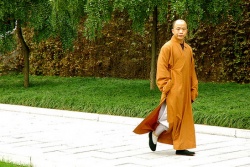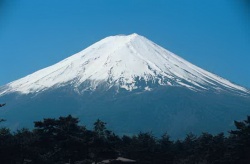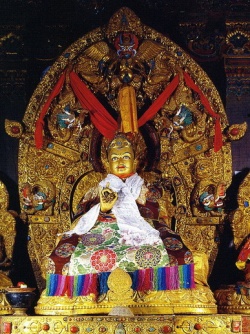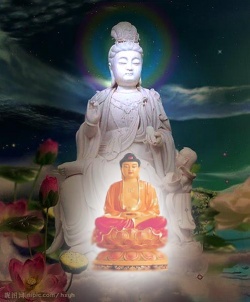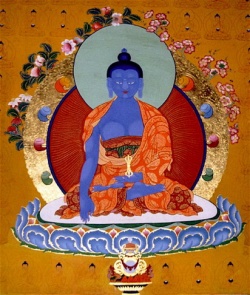Difference between revisions of "Khachoe Ghakyil Ling Nunnery"
| Line 1: | Line 1: | ||
| − | + | <nomobile>{{DisplayImages|2287|1382|3122|4019|1253|984}}</nomobile> | |
Latest revision as of 18:42, 23 November 2015
Khachoe Ghakyil Ling Nunnery, a branch of Kopan Monastery, was born from Lama Yeshe and Lama Zopa Rinpoche's inspiration and kindness. In 1979 the lamas invited two young women who had just escaped from Tibet to join their monastery in Kathmandu. The growing community of nuns lived and studied at Kopan Monastery till in 1990 when land was acquired to build a nunnery - a gompa with living quarters above, on the hill below Kopan.
The nunnery was opened in 1994 with a grand ceremony and given the auspicious name of Khachoe Ghakyil Ling – Pure Land of Bliss. One hundred and twenty five nuns moved to the new home at that time. Within the next 20 years it developed into one of the biggest nunneries in Nepal.
The nunnery is home to 360 nuns, many of them refugees from Tibet.
All of them are women who wish to be nuns and follow their spiritual calling. The nunnery is administered by a committee under the guidance of the Kopan abbot.
It has now a branch in Sarnath near Varanasi in India, Yulo Koepa, where fifteen nuns live and practice.
Traditionally, ritual arts and scholastic study have been a prerogative of Tibetan Buddhist monks, with their ordained sisters receiving little or no training in these areas and being relegated to performance of prayers for the lay community.
In Khachoe Ghakyil Nunnery, however, this is not the case.
The nuns of Khachoe Ghakyil Nunnery have had the doors of classical Buddhist education opened to them.
They are provided with highly trained scholars to teach them, and are instructed in debate, the performance of ritual music, the creation of sand mandalas, and other ritual arts.
Not surprisingly, once given access to scholastic training, the nuns have shown an intense determination to excel in their studies.
Their studies include Tibetan and English language, mathematics, philosophy, meditation, debate, rituals, chanting and art, along with other teachings and practice of the Buddha.
Their goal is to become qualified Dharma teachers so that they may teach others, at their mother nunnery and in Dharma centers internationally.
The key to the success of Khachoe Ghakyil Ling Nunnery lies in its approach to education.
Whereas even as little as 30 years ago, nuns were performing pujas and prayers, reciting mantras, and performing the Nyung ne retreat, Lama Yeshe's vision for the nunnery was very different.
Seeing the potential in these intelligent young women for a deeper understanding of Dharma, he insisted from the beginning that the nuns follow the same schedule of study as the monks.
Soon a geshe study program was established, (the geshe degree is the monastic equivalent of a Doctor of Divinity) with the prospect of obtaining a geshe degree- one of only few nunneries in India and Nepal to offer such an opportunity to their nuns.
Two of their members will receive their geshe ma degree in a few years time, together with nuns from other nunneries, a first in Tibetan Buddhist history.
Providing this kind of Dharma education also plays an important role in the preservation of the Dharma outside Tibet, where the teachings of the Buddha are under constant threat of extinction..
The nuns receive training in all aspects of Buddhist teachings, including philosophy, ritual arts, chanting, and playing ritual music as well as general knowledge subjects and languages.
By providing secure living conditions, the teachers, and an inspiring environment, the nunnery was set on the path to success.
Great emphasis is put on the philosophy study program at Khachoe Ghakyil Ling Nunnery.
The curriculum is based on the same 16- year course of philosophical study as the monks.
Groups of nuns now participate regularly on the annual inter-monastic debate.
This debate is hosted by the various nunneries that participate in the Geshe study program in India and Nepal.
Meeting on the debate courtyard is not just an intellectual exchange; it also lays the foundation for a network of future teachers that will work together.
The nuns engage in regular retreats such as the preliminary retreats of the Tibetan tradition. Several of them have achieved the three year retreat under the guidance of Geshe lama Konchok.
On advice of Lama Zopa Rinpoche, every year the Nyung Ne Fasting Retreat is held during the month of Shakyamuni Buddha’s Enlightenment (Saka Dawa).
It consists of eight 2-day sessions of prostration, fasting and silence, focused on the Buddha of Compassion, Chenrezig..
Not all nuns are following the higher study program. Some of them are serving the community through work as teachers, administrators and managers. Others are working in the incense factory, a fundraising arm of the nunnery that manufactures incense for customers all over the world.
The New Nunnery Buildings
Accommodation for the nuns has always been very cramped, mostly due to the fast increase in nuns over the past 20 years. With four to five people sharing a room study can become quite difficult.
The hygienic conditions also are very poor.
Some years ago, a master plan for the nunnery was developed, which included a new assembly hall, 100 rooms, a kitchen/dining room block and a large debate hall.
The latest addition to the master plan is the stupa for Hens lama Lhundrup, which will be built in the middle of the court yard in from of the new gompa.
In spring this year many nuns moved into their new rooms - what a relief for them. Two people sharing an airy, large room with clean bathrooms nearby - that marks a a huge improvement in the living conditions.
The plans are now underway for the opening of the new buildings and the consecrations of the new gompa for 2015.
The new gompa looks already stunning. Extensive paintings cover the walls - all the Deities, Buddhas, Arhats, mandalas of every kind adorn the ceiling.
The center piece is a 20 foot statue of 1000 arm Chenrezig, with statues of Manjushri and the 21 Taras on either side.
